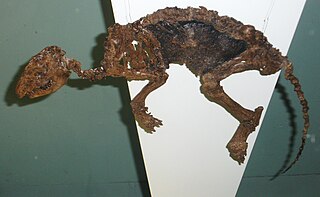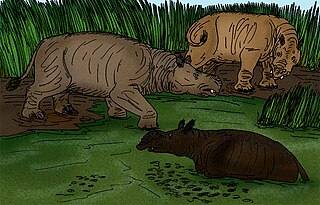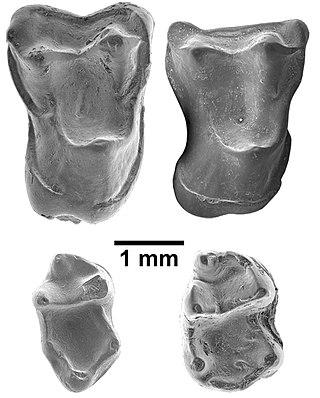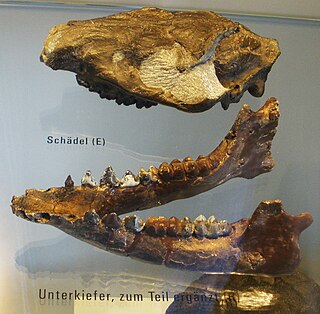
Chevrotains, or mouse-deer, are diminutive, even-toed ungulates that make up the family Tragulidae, and are the only living members of the infraorder Tragulina. The 10 extant species are placed in three genera, but several species also are known only from fossils. The extant species are found in forests in South and Southeast Asia; a single species, the water chevrotain, is found in the rainforests of Central and West Africa. In November 2019, conservation scientists announced that they had photographed silver-backed chevrotains in a Vietnamese forest for the first time since the last confirmed sightings in 1990.

Elomeryx is an extinct genus of artiodactyl ungulate, and is among the earliest known anthracotheres. The genus was extremely widespread, first being found in Asia in the middle Eocene, in Europe during the latest Eocene, and having spread to North America by the early Oligocene. The closest living relatives of the Elomeryx are bovids, suids, and cetaceans.
Hsanotherium is an extinct genus of early ungulate from the middle Eocene, described in 2000 in the Pondaung Formation, Myanmar.

Dichobunidae is an extinct family of basal artiodactyl mammals from the early Eocene to late Oligocene of North America, Europe, and Asia. The Dichobunidae include some of the earliest known artiodactyls, such as Diacodexis.

Amynodontidae is a family of extinct perissodactyls related to true rhinoceroses. They are commonly portrayed as semiaquatic hippo-like rhinos but this description only fits members of the Metamynodontini; other groups of amynodonts like the cadurcodontines had more typical ungulate proportions and convergently evolved a tapir-like proboscis.
Anthracothema was a genus of extinct artiodactyl ungulate mammals that lived in Myanmar during the late Eocene.

Anthracokeryx is a genus of extinct artiodactyl ungulate mammal belonging to Anthracotheriidae that lived in Asia during the middle to late Eocene.
Anthracohyus was a genus of extinct artiodactyl ungulate mammal belonging to Anthracotheriidae that lived in Asia during the middle to late Eocene.
Xinyuictis is an extinct genus of placental mammals from clade Carnivoraformes, that lived in Asia from the early to late Eocene.
Dermotherium is a genus of fossil mammals closely related to the living colugos, a small group of gliding mammals from Southeast Asia. Two species are recognized: D. major from the Late Eocene of Thailand, based on a single fragment of the lower jaw, and D. chimaera from the Late Oligocene of Thailand, known from three fragments of the lower jaw and two isolated upper molars. In addition, a single isolated upper molar from the Early Oligocene of Pakistan has been tentatively assigned to D. chimaera. All sites where fossils of Dermotherium have been found were probably forested environments and the fossil species were probably forest dwellers like living colugos, but whether they had the gliding adaptations of the living species is unknown.

Afrasia djijidae is a fossil primate that lived in Myanmar approximately 37 million years ago, during the late middle Eocene. The only species in the genus Afrasia, it was a small primate, estimated to weigh around 100 grams (3.5 oz). Despite the significant geographic distance between them, Afrasia is thought to be closely related to Afrotarsius, an enigmatic fossil found in Libya and Egypt that dates to 38–39 million years ago. If this relationship is correct, it suggests that early simians dispersed from Asia to Africa during the middle Eocene and would add further support to the hypothesis that the first simians evolved in Asia, not Africa. Neither Afrasia nor Afrotarsius, which together form the family Afrotarsiidae, is considered ancestral to living simians, but they are part of a side branch or stem group known as eosimiiforms. Because they did not give rise to the stem simians that are known from the same deposits in Africa, early Asian simians are thought to have dispersed from Asia to Africa more than once prior to the late middle Eocene. Such dispersals from Asia to Africa also were seen around the same time in other mammalian groups, including hystricognathous rodents and anthracotheres.
The Amphipithecidae were simian primates that lived in Late Eocene and Early Oligocene. Fossils have been found in Myanmar, Thailand, and Pakistan. The limited fossil evidence is consistent with, but not exclusive to, arboreal quadrupedalism. In other words, the species may have moved about in trees on four legs, but not with regular leaping as seen in later simians.

Tom Ducrocq is a French professional footballer who plays as a midfielder for Ligue 2 club SC Bastia.

Helohyidae were a group of artiodactyl mammals. They were most prominent in the mid-to-upper Eocene.

Achaenodon is an extinct artiodactyl mammal, possibly belonging to the family Helohyidae. It lived in the mid-late Eocene and its fossil remains have been found in North America.

Hyainailourinae ("hyena-cats") is an extinct subfamily of hyainailourid hyaenodonts that lived in Africa, Asia, North America and Europe from the middle Eocene to middle Miocene. They appeared in Africa about 47.8 Ma ago and soon after spread as far as East Asia.

The bothriodontines are a paraphyletic assemblage of anthracotheres that originated from Eurasia in the late middle Eocene (Bartonian). The group can be distinguished from other anthracothere lineages by their upper molars with the mesostyle that is occupied by the transverse valley, selenodont cusps, ventrally concave symphysis, elongated muzzles, with presence of a diastema between the canine and first premolar. The size range of the group ranged from small, basal forms to larger and more derived forms. During their evolution, the bothriodontines undergone a trend from evolving from small basal forms such as Qatraniodon into larger taxa such as Libycosaurus and Merycopotamus. Some genera the snouts became even more elongated and teeth specialized in a folivorous diet, while others like Merycopotamus became wide, heavy and shallow muzzles with teeth more adapted for grazing.

The microbunodontines were an extinct subfamily of anthracotheres that were predominately a Paleogene group of Eurasian artiodactyls. The group died out at the end of the Late Miocene. It comprised the genera Anthracokeryx, Geniokeryx, Microbunodon, and possibly Etruscotherium. They are different from the other anthracothere lineages by their smaller size, slenderer limbs and male specimens having laterally compressed, longer canines. They were originally classified as members of the other subfamily of anthracotheres, Anthracotheriinae but recent phylogenetic studies have found them to be their own clade sister to Bothriodontinae.

The anthracotheriines are an extinct subfamily of anthracotheres that comprised Paleogene to early Neogene North American and Eurasian artiodactyls. The group contained the genera Anthracotherium, Heptacodon, and Paenanthracotherium, as well as possibly Myaingtherium and Siamotherium. They were small to large sized anthracotheres, and when compared to the other two subfamilies, Microbunodontinae and Bothriodontinae, anthracotheriines are found to occupy a primitive, basal position in the family.
Heptacodon is an extinct genus of anthracothere endemic to North America during the Paleogene. They were medium to large-sized anthracotheres with a distinct facial features such short heavy rostrums and robust but simple molars. Heptacodon is a member of the anthracothere subfamily Anthracotheriinae, whose distribution as a whole are in North America and Eurasia. However Heptacodon has only been found in North America, with the species H. yeguaensis from Texas representing the oldest known anthracotheres to be found in North America dating to the middle Eocene. Fossils of this genus have been found in the states of North Dakota, Oregon, South Dakota, Texas, and Utah.












